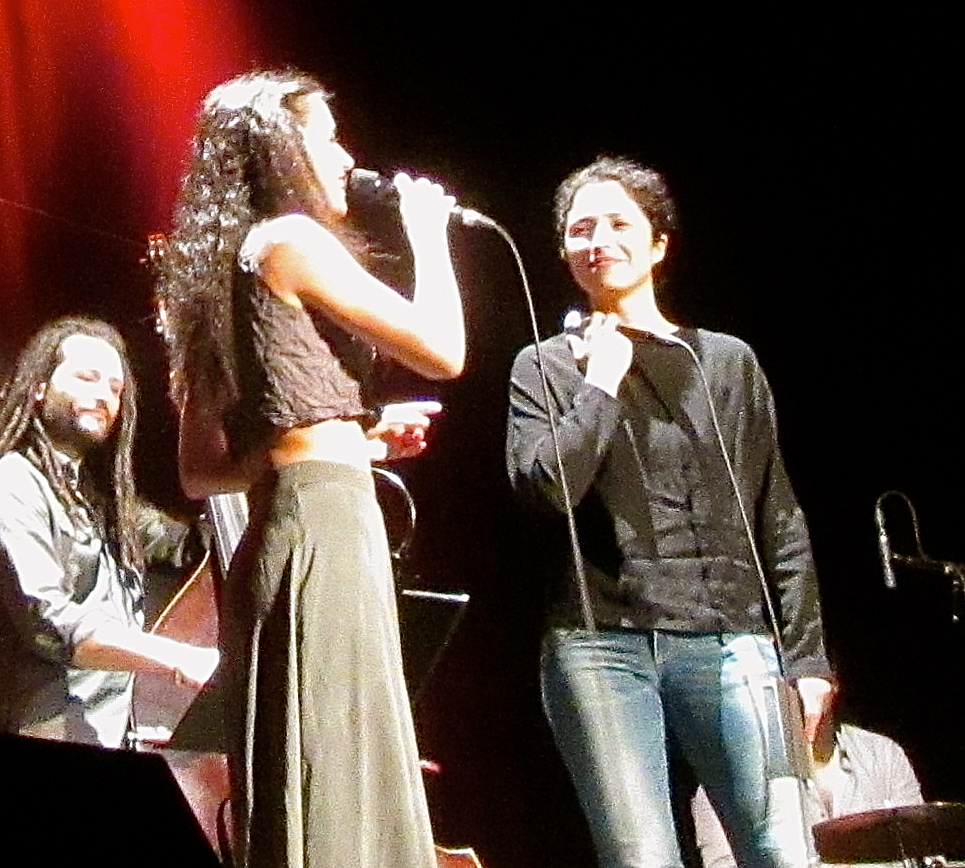I would no more call what Lara Bello does “fusion” than I would the diverse flowers of a meadow seeded by the winds. The flora of her landscape seem to have landed there quite naturally and grown at their own pace. Flamenco, jazz, and folk, the genres of North Africa, the Near East, Asia, Iberia, and South America, intertwine and cross-pollinate unselfconsciously and with no need to impress. She, of course, allows this to happen, permits and encourages the cross-pollination and intertwining of roots and branches, and in that way cultivates and presents it.
I don’t think I’ve been so struck by the variety of her art as I was on Friday in Madrid, when I saw Bello for the first time in her home country. La Fundación SGAE sponsored her, at Sala Berlanga, as part of a series called Flamencos y mestizos. The title translates roughly as “flamencos and cultural mixtures,” and it could have been chosen just for Bello. The mix doesn’t happen only as a whole, but within individual songs, whether originals or covers, and sometimes one is not sure what, if any, influence is primary. The concert began with a slow hum into the microphone and morphed within minutes into jazz, folk, and world traditions. Something in the sensibility of her interpretations reveals origins and tracks their evolution. “Tonada de luna llena,” for example, is a Venezuelan song made famous by Simón Díaz, but Bello’s singing of it suggested a more complex vintage to the song type. A tonada is a lyric driven genre that came to South America from Northern Spain, but listening to Bello sing it (accompanied only by percussion, and herself on maracas), makes one wonder if its sources aren’t even deeper, perhaps African or Near Eastern, affinities she unveils in the song rather than imposes upon it.
Her variety isn’t just a matter of forms and genres. It comes from the fact that she is, in one person, many, a singer practiced in dance, literature, and the dramatic arts. To experience how varied she is, you have to see her: arms outstretched and undulating like charmed snakes; motions redolent of flamenco, Arabic, or Indian dance; the one-two-three thumb snaps of jazz; a scarf and trail handled theatrically, but with respect, as flamenco, belly, or sufi dancers do. There’s an intuitive symbolism in the way she uses fabrics, a reverberation of the value of cloth before mass production, which I’ve seen from her before, in concerts of the songs of Lorca or from her CD Primero amarrillo después malva.
She was accompanied by Alberto Palau (piano), Ales Cesarini (bass), and José Montaña (percussion), and invited two guests onto the stage with her. A vivid and passionate player of the saxophone, José Vera Bello (to whom she is unrelated, except by stage joke), accompanied her in several numbers. And Rocio Rico Romero, a Spanish singer based in Italy (to the reader’s right in the photo), joined her in a generous, swelling duet of Bello’s “Suave.” It was one of a couple of works in the concert not yet on CD. Another was the haunting “Hind y amor,” from a collaboration with Tariq Ali that dramatized his novel Shadows of the Pomegranate Tree. Part of Bello’s receptiveness, as a vessel of many styles and influences, comes from her background as a native of Granada (which means “pomegranate” in Spanish), the Islamic heritage of which is the novel’s subject.
Bello, although I think of her as based in New York, has a sizable and appreciative Spanish following. Sala Berlanga is a good-sized house that was nearly full. I was glad to be among them to witness this tender of gardens musical and theatrical, who manages, somehow, to remain both organic and inventive.
For information on Lara Bello, visit her here.
